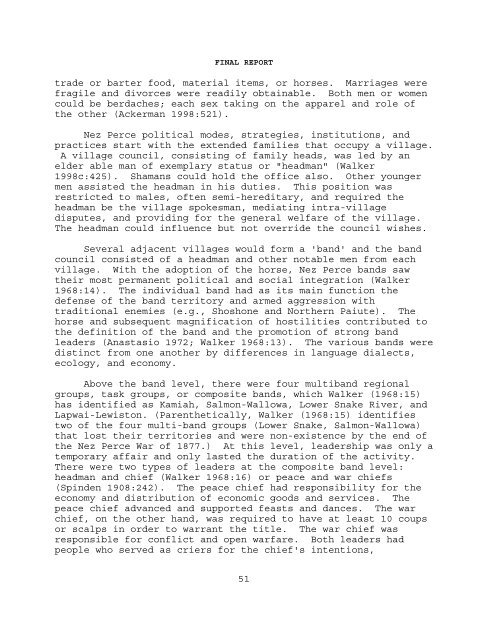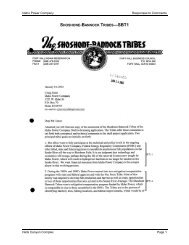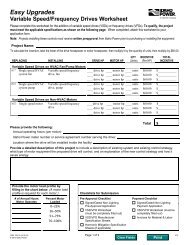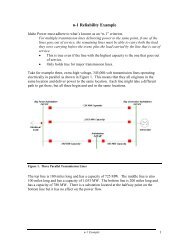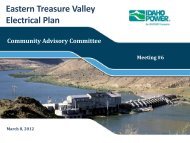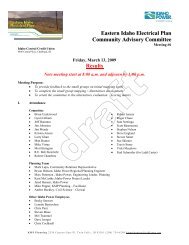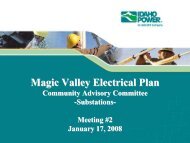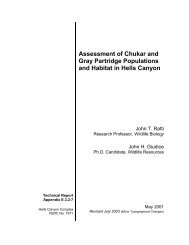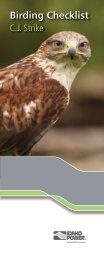(E.4-12) An Archival Review and Ethnographic Study ... - Idaho Power
(E.4-12) An Archival Review and Ethnographic Study ... - Idaho Power
(E.4-12) An Archival Review and Ethnographic Study ... - Idaho Power
You also want an ePaper? Increase the reach of your titles
YUMPU automatically turns print PDFs into web optimized ePapers that Google loves.
FINAL REPORTtrade or barter food, material items, or horses. Marriages werefragile <strong>and</strong> divorces were readily obtainable. Both men or womencould be berdaches; each sex taking on the apparel <strong>and</strong> role ofthe other (Ackerman 1998:521).Nez Perce political modes, strategies, institutions, <strong>and</strong>practices start with the extended families that occupy a village.A village council, consisting of family heads, was led by anelder able man of exemplary status or "headman" (Walker1998c:425). Shamans could hold the office also. Other youngermen assisted the headman in his duties. This position wasrestricted to males, often semi-hereditary, <strong>and</strong> required theheadman be the village spokesman, mediating intra-villagedisputes, <strong>and</strong> providing for the general welfare of the village.The headman could influence but not override the council wishes.Several adjacent villages would form a 'b<strong>and</strong>' <strong>and</strong> the b<strong>and</strong>council consisted of a headman <strong>and</strong> other notable men from eachvillage. With the adoption of the horse, Nez Perce b<strong>and</strong>s sawtheir most permanent political <strong>and</strong> social integration (Walker1968:14). The individual b<strong>and</strong> had as its main function thedefense of the b<strong>and</strong> territory <strong>and</strong> armed aggression withtraditional enemies (e.g., Shoshone <strong>and</strong> Northern Paiute). Thehorse <strong>and</strong> subsequent magnification of hostilities contributed tothe definition of the b<strong>and</strong> <strong>and</strong> the promotion of strong b<strong>and</strong>leaders (<strong>An</strong>astasio 1972; Walker 1968:13). The various b<strong>and</strong>s weredistinct from one another by differences in language dialects,ecology, <strong>and</strong> economy.Above the b<strong>and</strong> level, there were four multib<strong>and</strong> regionalgroups, task groups, or composite b<strong>and</strong>s, which Walker (1968:15)has identified as Kamiah, Salmon-Wallowa, Lower Snake River, <strong>and</strong>Lapwai-Lewiston. (Parenthetically, Walker (1968:15) identifiestwo of the four multi-b<strong>and</strong> groups (Lower Snake, Salmon-Wallowa)that lost their territories <strong>and</strong> were non-existence by the end ofthe Nez Perce War of 1877.) At this level, leadership was only atemporary affair <strong>and</strong> only lasted the duration of the activity.There were two types of leaders at the composite b<strong>and</strong> level:headman <strong>and</strong> chief (Walker 1968:16) or peace <strong>and</strong> war chiefs(Spinden 1908:242). The peace chief had responsibility for theeconomy <strong>and</strong> distribution of economic goods <strong>and</strong> services. Thepeace chief advanced <strong>and</strong> supported feasts <strong>and</strong> dances. The warchief, on the other h<strong>and</strong>, was required to have at least 10 coupsor scalps in order to warrant the title. The war chief wasresponsible for conflict <strong>and</strong> open warfare. Both leaders hadpeople who served as criers for the chief's intentions,51


